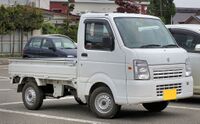Svaartaron MUV
| Svaartaron MUV | |
|---|---|
 | |
| Overview | |
| Manufacturer | Svaartaron |
| Also called | OTMO Move |
| Production | 1960 - present |
| Assembly | Torsfeld, FCE, Ottonia |
| Designer | Jord Farrangur (original design) |
| Body and chassis | |
| Class | Light Truck, Kei Vehicle |
| Body style | 2 door pickup 5 door van/microbus |
| Layout | FMR |
| Platform | Otmo Mini Utility Platform |
| Powertrain | |
| Engine | 660 cc I3 660 cc I3-T 800 cc I4 1.0L I4 Engine (Non-LV model) |
| Transmission | 3 speed automatic 4 speed manual |
| Dimensions | |
| Wheelbase | 1910 mm (Truck) 2450 mm (Van) |
| Length | 3400 mm |
| Width | 1500 mm |
| Height | 1900 mm |
| Curb weight | 700 - 1000 kg |
The Svaartaron MUV is a family of minitrucks and microvans produced by the Ottonian automaker Svaartaron. The line has been produced continuously since 1960 over ### generations.
Like many Svaartaron vehicles, the MUV carries a reputation for reliability and ease of repair, and as such they are popular among tradesmen, small business owners, small farmers, and taxi fleets. The MUV is classified under Ottonian law as a Light Truck, granting buyers tax benefits and allowing it to take advantage of more lax municipal and federal parking and traffic regulations. Outside of North Ottonia, they are marketed and sold through the Ottonian Motor Cooperative's Otmo marque.
Development
After a decade of post-Revolution auto sales and development, Svaartaron had determined that marketshare was being lost to burgeoning competitors at Vulksmotor and SEDA due to the successful L-Ute mostly being preferred by government buyers and those who had to contend with bad or insufficient roads. In more developed spaces, the L-Ute was often unfavorably compared to the more space-efficient Vulksmotor U-SL and the SEDA Poni, due to its longer hood and smaller bed. Seeking to rectify this, designer Jord Farrangur was tasked in 1956 with designing a more space- and fuel-efficient light truck for Svaartaron's expanding line.
First Generation
The first fruits of Farrangur and his workshop's efforts rolled off the assembly line in 1960. The initial run of the